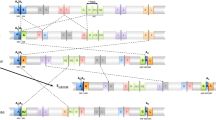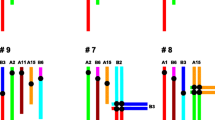Abstract
The mitotic and meiotic chromosomes of five populations of Eleutherine bulbosa were analysed after C-banding and fluorochrome (DAPI/CMA) staining. All individuals showed heterozygosity in pair number I for a pericentric inversion and a tandem duplication in the inverted region of one of the homologues. The duplication comprised the secondary constriction and ca. 40% of its associated CMA+ heterochromatin. All the secondary constrictions were nucleolar organizers, but the repeated one seemed to be the most active. The inverted segment constituted ca. 70% of the chromosome length and included, in addition to the duplication and the centromere, two DAPI+ C-bands. These markers, especially the CMA+ blocks which were unique in the complement, permitted a detailed analysis of meiotic pairing. In practically all examples of late zygotene the CMA blocks were paired, which seems to mean that non-homologous pairing never occurred. At this stage the duplicated CMA+ block was clearly unpaired. At pachytene-diplotene the inverted region formed a typical loop without chiasmata. Although male meiosis was normal, no indication of sexual reproduction was found. A causal relationship between duplication, inversion and asexual reproduction is proposed to explain the maintenance of the heterozygosity.
Similar content being viewed by others
References
Brandham PE (1975) Stabilised breakage of a duplicated chromosome segment in Aloe. Chromosoma 51:269–278
Brandham PE, Johnson MAT (1977) The meiotic behaviour of inversions in polyploid Aloineae. Chromosoma 62:85–91
Frankel OH (1949) A self propagating structural change in Triticum. I. Duplication and crossing over. Heredity 3:163–194
Giles NH (1944) A pericentric inversion in Gasteria resulting in apparent isochromosomes at meiosis. Proc Natl Acad Sci USA 30:1–5
Gillies CB (1984) The synaptonemal complex in higher plants. CRC Crit Rev Plant Sci 2:81–116
Goldblatt P (1982) Chromosome cytology in relation to suprageneric systematics of neotropical Iridaceae. Syst Bot 7:186–198
Guerra MS (1983) O uso de Giemsa na citogenética vegetal — comparação entre a coloração simples e o bandeamento. Ci e Cult 35:190–193
Guerra MS (1985) Heterozigosidade estrutural em Eleutherine plicata Herb, (Iridaceae). Ci e Cult 37 (Supl.):773
Hale DW (1986) Heterosynapsis and supression of chiasmata within heterozygous pericentric inversions of the Sitka deer mouse. Chromosoma 94:425–432
John B, Lewis KR, Henderson, SA (1960) Chromosome abnormalities in a wild population of Chortippus brunneus. Chromosoma 11:1–20
Kenton A, Heywood CA (1984) Cytological studies in South American Iridaceae. Pl Syst Evol 146:85–104
Kodama Y, Yoshida MC, Sasaki M (1980) An improved silver staining technique for nucleolus organizer regions by using a nylon cloth. Jpn J Hum Genet 25:229–233
Kurnit DM (1979) Satellite DNA and heterochromatin variants: the case for unequal mitotic crossing-over. Hum Genet 47:169–186
Lande R (1984) The expected fixation rate of chromosomal inversions. Evolution 38:743–752
Loidl J (1987) Synaptonemal complex spreading in Allium ursinum: pericentric asynapsis and axial thickenings. J Cell Sci 87:439–448
Maguire MP (1966) The relationship of crossing over to synaptic extent at pachytene in maize. Genetics 51:23–40
Maguire MP (1982) Evidence for a role of the synaptonemal complex in provision for normal chromosome disjunction at meiosis II in maize. Chromosoma 84:675–686
Martinez A, De Azkue D (1987) Variacion del contenido de ADN, y su implicancia evolutiva. Anales del IV Congresso Latinoamericano de Botanica III:35–55
McClintock B (1931) Cytological observations of deficiencies involving known genes, translocations and an inversion in Zea mays. Missouri Agric Exp Stat Bull 163:1–30
McClintock B (1933) The association of non-homologous parts of chromosomes in the mid-prophase of meiosis in Zea mays. Z Zellforsch Mikrosk Anat 19:191–237
Morgan DT (1950) A cytogenetic study of inversions in Zea mays. Genetics 35:153–174
Moses MJ, Poorman PA (1984) Synapsis, synaptic adjustment and DNA synthesis in mouse oocytes. Chromosomes Today 8:90–103
Noda S (1974) Chiasma studies in structural hybrids IX. Crossing-over in pericentric inversion of Scilla scilloides. Bot Mag 87:195–208
Nur U (1968) Synapsis and crossing over within a paracentric in- version in the grasshopper Camnula pellucida. Chromosoma 25:198–214
Ohno S (1970) Evolution by gene duplication. Springer, New York, p 160
Peccinini-Seale D, Frota-Pessoa O (1974) Structural heterozygosity in parthenogenetic populations of Cnemidophorus lemniscatus (Sauria, Teiidae) from the Amazonas Valley. Chromosoma 47:439–451
Poorman PA, Moses MJ, Russel LB, Cacheiro NLA (1981) Synaptonemal complex analysis of mouse chromosomal rearrangements. I. Cytogenetics observations on a tandem duplication. Chromosoma 81:507–518
Rao PN (1969) Chromosomal interchange in Eleutherine plicata Herb. Genetica 40:417–420
Sato S (1985) The structure of the nucleolus organizing regions in root tip meristems of Allium cepa. Caryologia 38:229–245
Schweizer D (1973) Vergleichende Untersuchungen zur Längsdifferenzierungen der Chromosomen von Vicia faba L. Verh Naturforsch Ges Basel 83:1–75
Schweizer D (1980) Simultaneous fluorescent staining of R bands and specific heterochromatic regions (DA-DAPI bands) in human chromosomes-Cytogenet Cell Genet 27:190–193
Sharma AK, Talukdar C (1959) Cytotaxonomical studies on some members of the Iridaceae with special reference to the structural heterozygosity of Cipura paludosa Aubl. Nucleus 2:63–84
Sjödin J (1971) Induced paracentric and pericentric inversions in Vicia faba L. Hereditas 67:39–54
Smith GP (1976) Evolution of repeated DNA sequences by unequal crossover. Science 191:528–535
Sturtevant AH (1925) The effects of unequal crossing-over at the Bar locus in Drosophila. Genetics 10:117–147
Sukhadev P, Janake PS, Murthy JVVSN, Rao MVS, Manga V (1985) Meiotic behavior of multiple interchange heterozygotes in pearl millet. Cytologia 50:347–350
Sybenga J (1975) Meiotic configurations. A source of information for estimating genetic parameters. Springer, Berlin, p 251
White MJD (1951) Structural heterozygosity in natural populations of the grasshopper Trimeratropsis sparsa. Evolution 5:376–394
White MJD (1970) Heterozygosity and genetic polymorphism in parthenogenetic animals. In: H Hecht, G Steere (eds) Essays in evolution and genetics in honour of Theodosius Dobzhansky. North-Holland, Amsterdam, pp 237–262
White MJD, Morley EHW (1955) Effects of pericentric rearrangements on recombination in grasshopper chromosomes. Genetics 40:604–619
Zaman MA, Begum R, Saha GR (1985) Karyomorphology and chromosome behaviour of a form of Eleutherine plicata Herb. (Iridaceae) with an aberrant chromosome number and a pericentric inversion. Caryologia 38:207–211
Author information
Authors and Affiliations
Rights and permissions
About this article
Cite this article
Guerra, M.d.S. Mitotic and meiotic analysis of a pericentric inversion associated with a tandem duplication in Eleutherine bulbosa . Chromosoma 97, 80–87 (1988). https://doi.org/10.1007/BF00331797
Received:
Revised:
Issue Date:
DOI: https://doi.org/10.1007/BF00331797




